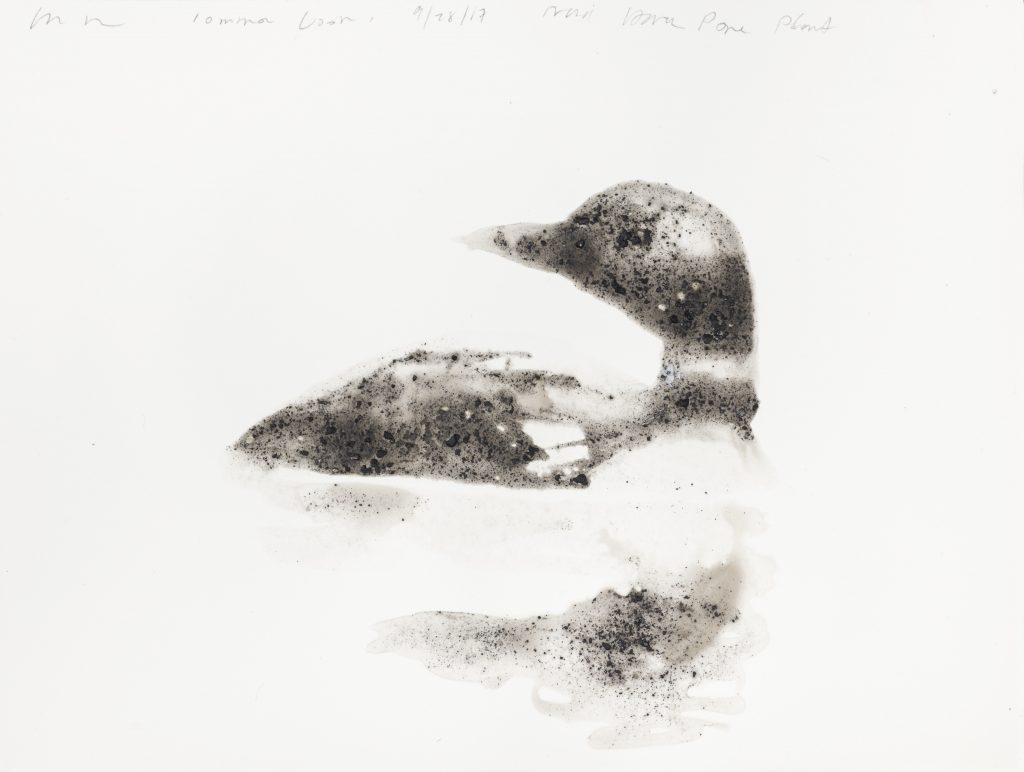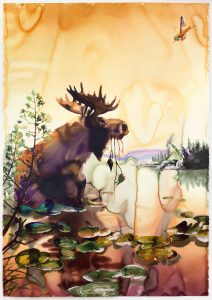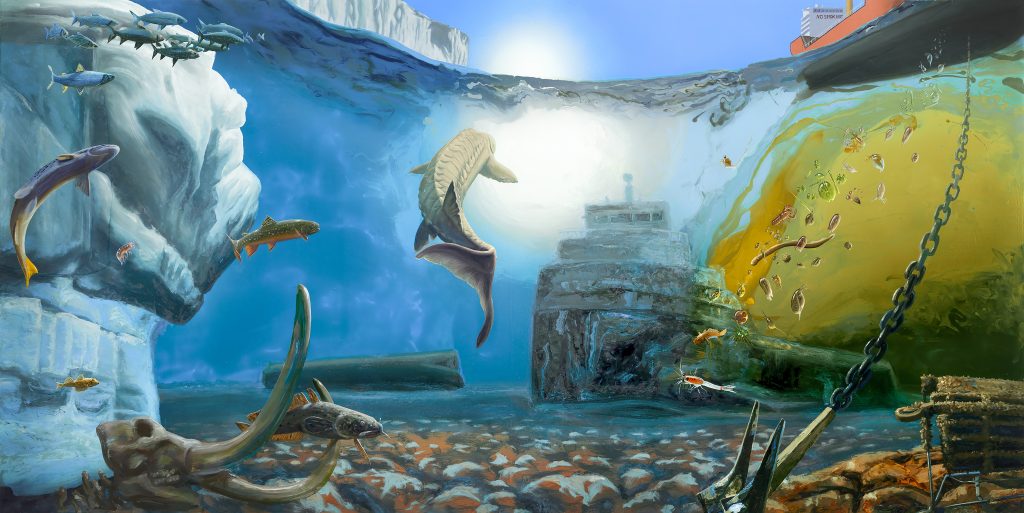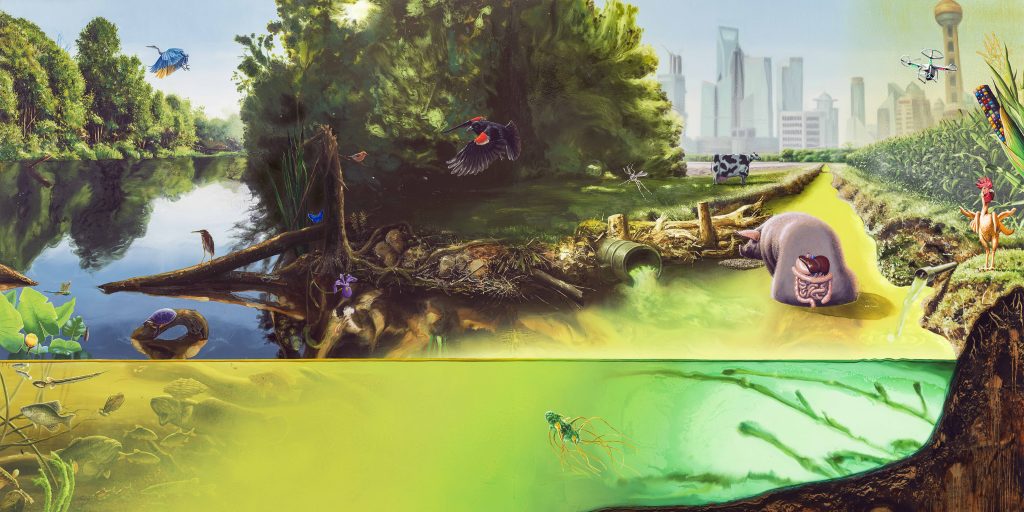This fall, WAM is proud to present Alexis Rockman: The Great Lakes Cycle. Organized by the Grand Rapids Art Museum (GRAM) in Michigan, the exhibition features an ambitious suite of paintings and works on paper by New York–based artist Alexis Rockman. In a state bound by Lake Superior and part of a region contiguous to Lake Michigan, Minnesotans are keenly aware of the importance, robustness, and fragility of these shining, open waters.
The Great Lakes are one of the world’s great natural treasures. They hold more than 20 percent of the Earth’s fresh water and are one of the most beautiful, economically significant, and ecologically complex regions on our planet. Together, the lakes and their associated rivers and canals form an interconnected water system that extends from the continent’s heartland to the world’s oceans. They are among the most precious resources to the future of humanity and all life on Earth.
Intrigued by and concerned about this essential water system, The Great Lakes Cycle developed out of Alexis Rockman’s rigorous research, travel, and interaction with people in the region—especially scientists who specialize in the lakes and their ecosystems. Rockman has translated this information from first-hand experiences to biological facts, to digital sketches, and finally to the works we’ll display. The culmination of this intensive research project—the exhibition—is divided into three sections: field drawings, large-scale watercolors, and monumental, mural-sized paintings.

During his travels to the region’s varied ecosystems, Rockman collected dirt, sand, leaves, and other organic materials to create his field drawings—monochrome studies of flora and fauna. His first organically composed field drawings were created out of necessity in 1994, at the end of a six-week field expedition in Guyana when his pencils had run out of lead.
Rockman’s field drawings emphasize his observational and expressive talent, conveying both accurate physical description and the spontaneity possible in this small format and experimental process. The twenty-eight framed field drawings of The Great Lakes Cycle encompass a wide variety of species, sites, and materials. The fauna depicted includes the microscopic E. coli bacteria, pollinators such as the flying Lake Huron locust, and turtles, waterfowl, large fish, a raccoon, and a river otter. The sources for his pigments include sand from Whiskey Island along the Cuyahoga River, the beaches of Presque Isle off the coast of Lake Erie, and Michigan’s Sleeping Bear Dunes, and coal dust from the Grand Haven Power Plant near Grand Rapids, Michigan. Despite their name, the field drawings are not actually created in the field, nor are they made from in-person observation. According to Rockman, “I made them in the studio while reflecting on my field visits … [it has] more to do with the research and the specific material from which the works are made than it does with a traditional notion of scientific field studies.”
Often presenting a synthesized, idealized view of each species, the flattened vantage point mimics the language of traditional botanical prints. Rockman considers the field drawings to be in stark contrast to his paintings, explaining, “They are immediate. Because I am using soil or sand as the pigment, the outcome is so unpredictable. I never know how the drawing is going to come out.”
Rockman has an important parallel practice of work on paper, and he has created a dramatic suite of six watercolors for The Great Lakes Cycle. In this medium, the artist must embrace the risk and manage the blooms, ebbs, and flows of the fluid material in order to make a successful image. Working on large sheets cut from a roll of paper, Rockman wets the watercolors on the floor before moving them to a table. In a concentrated process over the course of only a few days, he shapes pigment into pools of water and passages to form an evocative, enveloping atmosphere, from which the images emerge.

In these vertically oriented works, Rockman is freed from the wide, horizontal sweep of his panorama paintings and is able to explore other pictorial possibilities. In some of these images, he adopts an unexpected, immersive point of view, such as a cutaway of an ice fishing scene or an urban creek polluted by industrial waste. Another harnesses magnification to make visible the microscopic plants and animals that compose the base of the food chain in the Great Lakes. Others capture and celebrate flora and fauna in their environment, enlarged for monumental impact.
Rockman’s mastery of watercolor painting distills an atmospheric energy and brings a lively spontaneity to the forefront. He explains: “For watercolors, I look for opportunities that can suspend the disbelief between the alchemy of the materials and the miracle of the image.”
The centerpiece of The Great Lakes Cycle is a suite of five panoramic paintings exploring themes that emerged during Rockman’s research, through direct observation and dialogue with scientists, historians, and anthropologists. In the development of each panorama, Rockman combines his notes and sketches with images found on the internet to create digital collages that allow him to “figure out what goes where.” Three of the paintings (Pioneers, Cascade, and Forces of Change) can be read from left to right as scientific and cultural timelines. Rockman embeds evidence from geological, climatic, biological, and human history within these broad vistas, often starting with the Pleistocene Epoch and the first humans 10,000 years ago, passing through the centuries to focus on humankind’s present relationship with the Great Lakes, and in some cases going beyond to a vision of the lakes’ futures. Once finished, each painting is accompanied by a key that notates the species, artifacts, and historical references embedded within each work.
Combining compositional approaches from the history of landscape painting with stylistic languages, pictorial practices, and the vocabularies of science, these paintings make visible the many stresses on the lakes’ ecological equilibrium. Beyond the visual impact of the series and the scientific information it carries, the scale and complexity of the project reflect Rockman’s passion for underscoring the importance of the Great Lakes far beyond their immediate region.
Born in 1962, Rockman was raised in New York City. As a child, he explored Central Park, watched early nature documentaries on television, and frequented the Museum of Natural History, where his mother worked for anthropologist Margaret Mead. This led to an interest in drawing animals and their environments. Rockman pursued art at the Rhode Island School of Design and Manhattan’s School of Visual Arts, and gained early recognition in the mid-1980s for his eerie bio-botanical scenes. The scope of his imagery expanded as he explored historical and contemporary artistic expression and mined the vernacular and practice of scientific representation. Driven by an intense curiosity about the natural world and an ambition to explore the pressing questions of our times, Rockman has been recognized for his impressive artistic range and for the intensity of his commitment to the environment and its preservation.
The Great Lakes Cycle explores the past, present, and future of the Great Lakes. While celebrating the natural majesty and global importance of the region, Rockman explores how the lakes are threatened by human forces including climate change, pollution, invasive species, mass agriculture, and urban sprawl. Some of the steps taken in recent decades to protect these ecosystems and counteract environmental damages have produced positive results, yet more attention is needed. It is our goal that The Great Lakes Cycle will create wider awareness of these issues and inspire everyone to play a role in protecting our environment and preserving these precious resources for future generations.


Alexis Rockman: The Great Lakes Cycle is organized by the Grand Rapids Art Museum, with support generously provided by the Wege Foundation, the National Endowment for the Arts, the Frey Foundation, and LaFontsee Galleries and Framing.
Images (Top – Bottom): (1) Alexis Rockman, Watershed, 2015, oil and alkyd on wood panel, 72 x 144 inches. Collection of Jonathan O'Hara Gallery, (2) Common Loon, 2017, coal dust from Grand Haven Power Plant and acrylic polymer on paper, 9 x 12 1/2 inches. Courtesy of the Artist and Sperone Westwater, New York, (3) Upper Peninsula, 2017, watercolor, ink, and acrylic on paper, 74 x 52 inches. Collection of Jonathan O'Hara Gallery, and (4) Pioneers, 2017, oil and acrylic on wood panel, 72 x 144 inches. Courtesy of the Artist and Sperone Westwater, New York.


